Trump Jr. Rips Brits For Freeing Terrorist; Critics Say His Dad Enabled 100s More To Escape
Posted in: Today's ChiliAfter Trump allowed Turkey to invade Syria, ISIS captives were able to escape from detention in Kurdish-held areas.
After Trump allowed Turkey to invade Syria, ISIS captives were able to escape from detention in Kurdish-held areas.
His wife Gabrielle Union posted a family photo that showed his 12-year-old son Zion wearing fake nails.

Sony calls the $1299 Sony RX100 VII a camera with “Pro features” in a to-go package and targets a creative crowd of professionals and influencers willing to spend to streamline their ultramobile camera setup.
I spent some time with the RX100 VII, and in this review, we’ll go over its real-world capabilities and whether I would use it in my day to day creative activities such as media event coverage, food photos, and pro-travel.
Since it is ultra-compact, I’ll also quickly compare it with the best mobile camera phones to show you why ultra-compacts need to push the envelope ever-farther.
It’s important to understand that I use a compact camera like this one mostly in auto-mode (to save time), as I would with a smartphone. As such, I expect it to capture the highest image quality possible with relatively good accuracy because “what I see” is my baseline.
This is my specific use case, and some photographers will do the opposite and use it in manual mode much more often.
Just to have a good idea of what the Sony RX100 VII is capable of, let’s look at the key specifications:
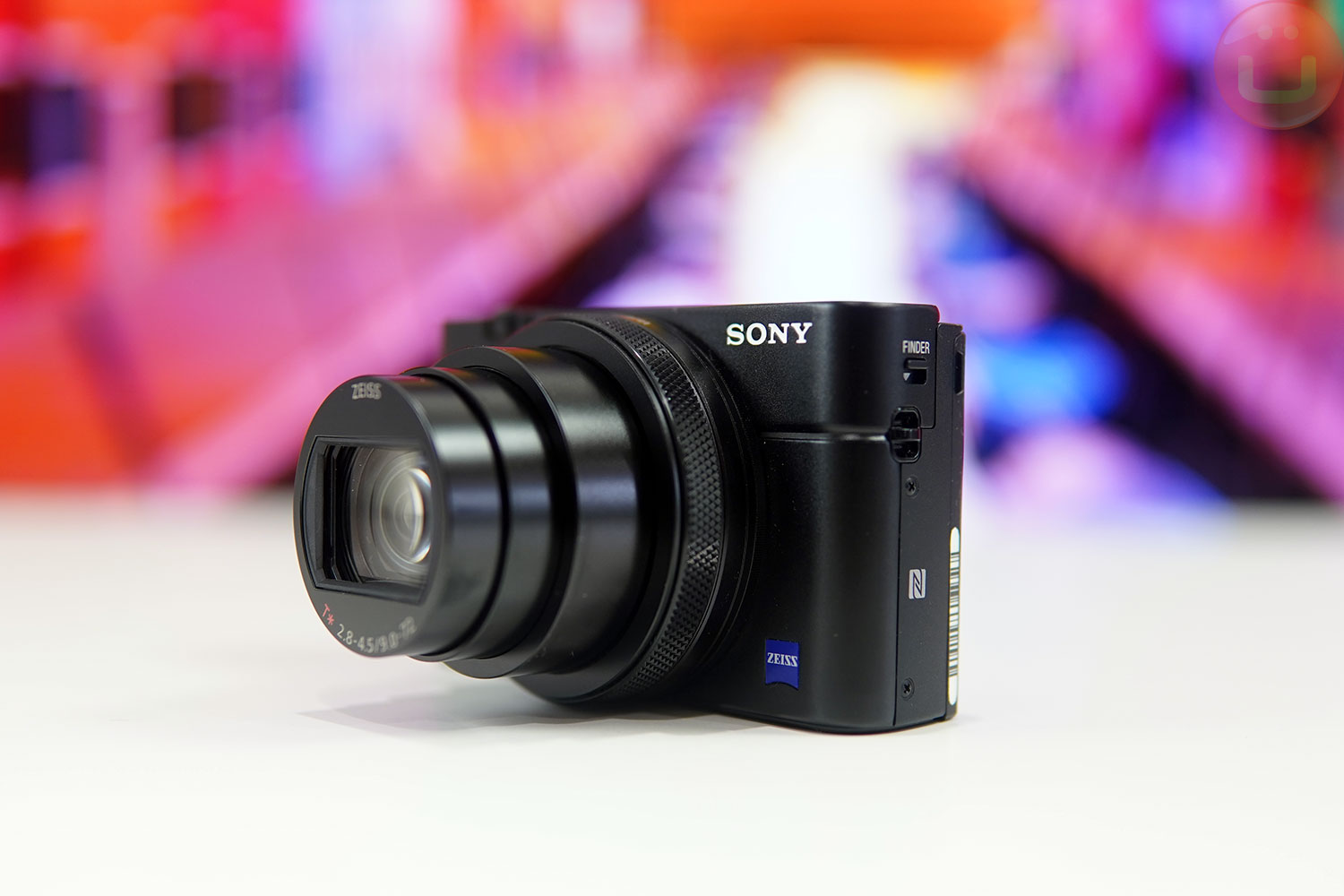
If the Sony RX100 VII looks very familiar, it is because it looks quasi-identical to the previous RX100 VI. It’s a great thing because this design remains the most compact in its category while remaining functional, but with a few things that could be improved upon.
When the lens is tucked in, the camera is incredibly compact. It fits a pants pocket (Levis 501 in my case) with a bit of room to spare. A vest/jacket pocket would be very comfortable, and in a bag or purse, you will forget it is even there.
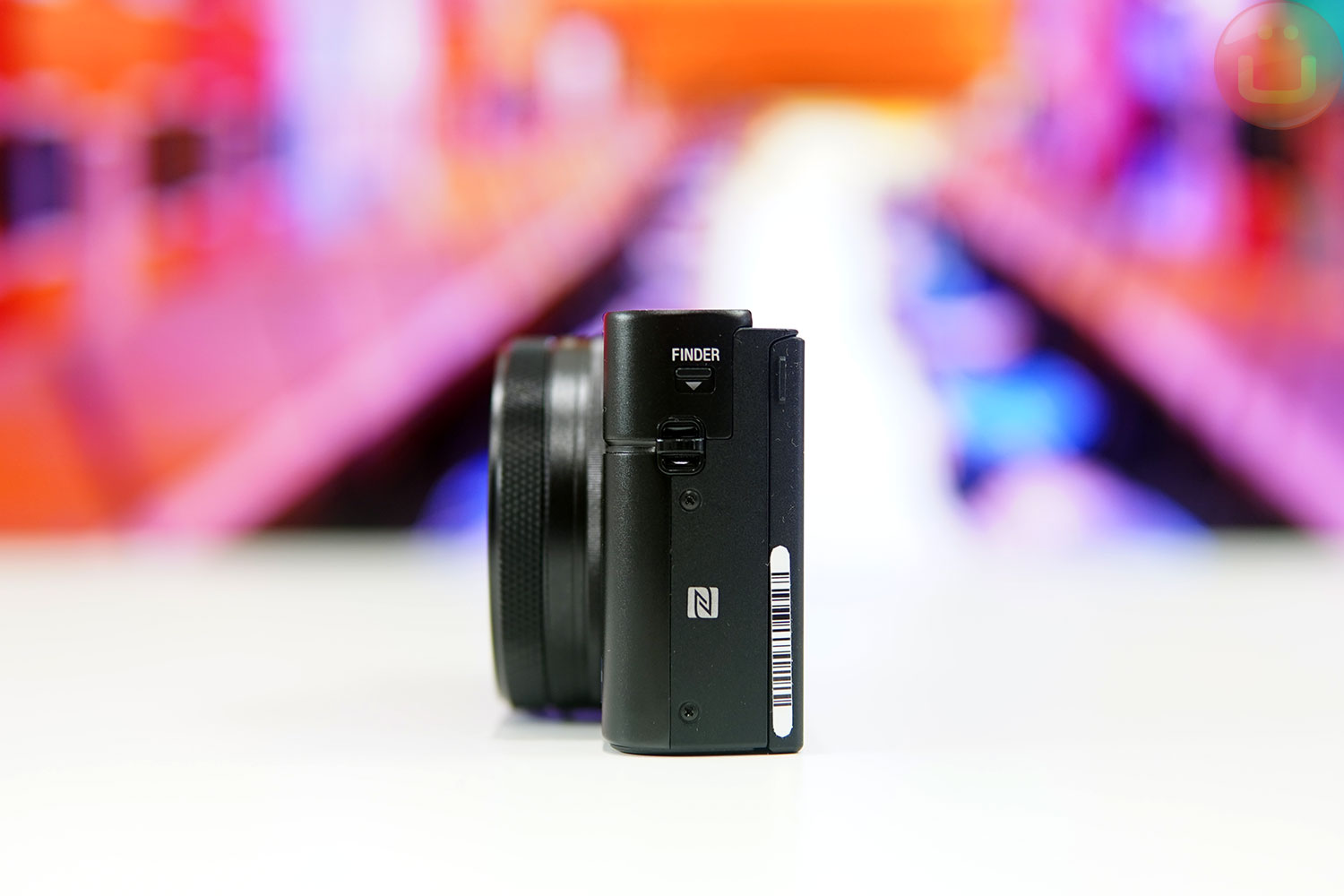
If you compare it with competitors in the same class and price range, this design is noticeably smaller, and I love the weight of 302g, which is about 1.5X that of a large phone. But there is a small price to pay: the lack of grip.
First, the smooth metal texture of the camera makes it a little slippery, so I recommend using the wrist strap or add some kind of textured surface or a custom grip accessory. Ideally, Sony could work the front metal surface to give it a little bit more texture and grip, as the ring has.
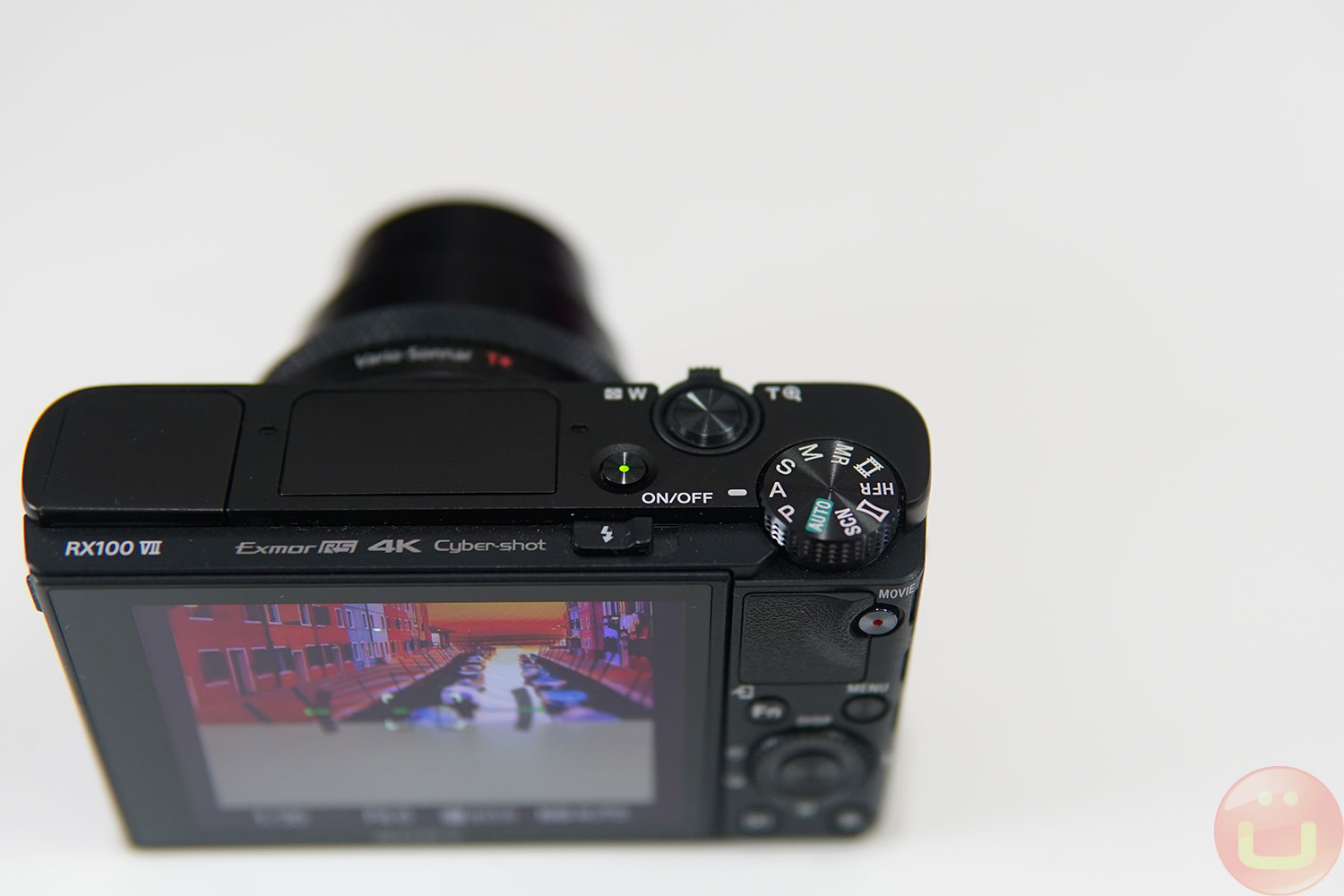
Secondly, the Power and Shutter buttons are flush to the surrounding surface, so they are sometimes a bit hard to find in low-light, especially the Power button. Because of their slightly larger sizes, competitors are often a bit more “tactile” with more physically defined buttons and knobs.
To the left, there is a hidden pop-up OLED viewfinder (2.36M pixels), which is very convenient in bright light situations where the LCD display may be overpowered by the environment’s light. Sony made it possible to turn ON the camera when the viewfinder pops-up, which is a nice touch.
To retract the viewfinder (VF), you have to press the lens first, then push the VF down. The pop-up part is faster, as you just need to pull the Finder tab/button to the left and the whole thing will pop-up and unfold.
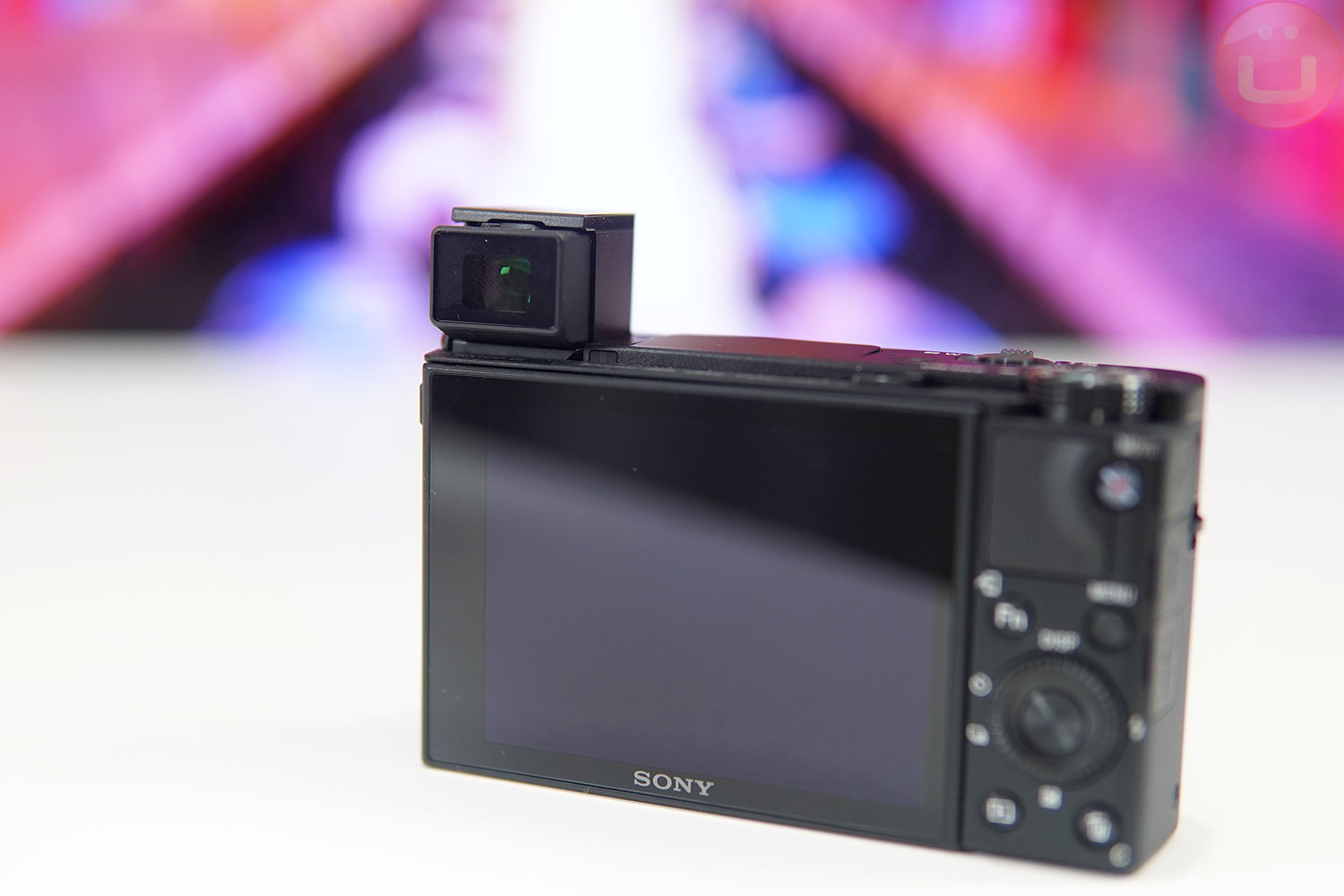
The lens has a ring that controls the zoom, which can also be controlled from the digital zoom controls near the shutter button. That ring has a smooth motion instead of the clicky controls that other cameras may have. I don’t mind, but it’s a matter of personal preferences.
The ring makes a lot of sense for photography, and of course, the digital zoom control is smoother when shooting videos.
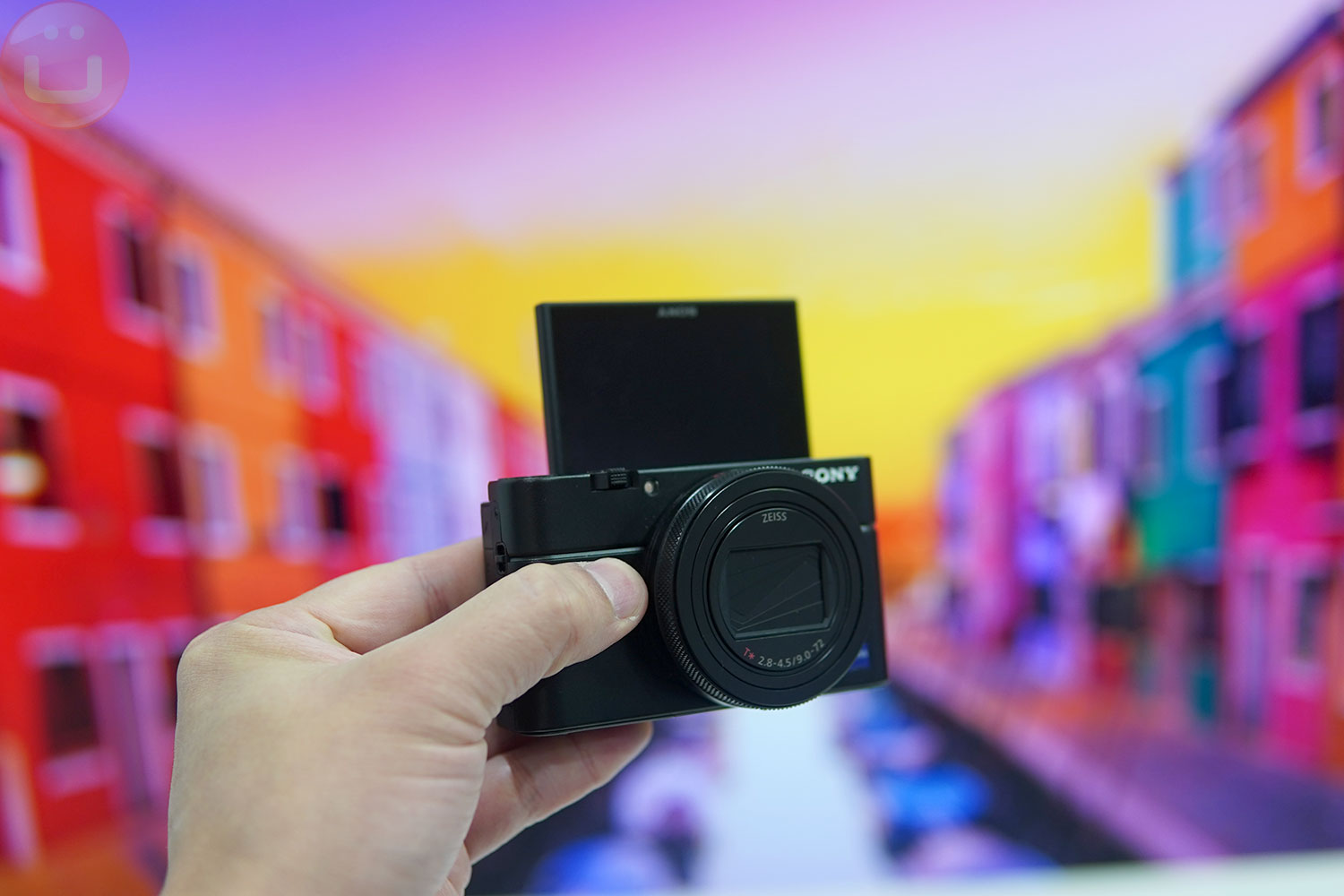
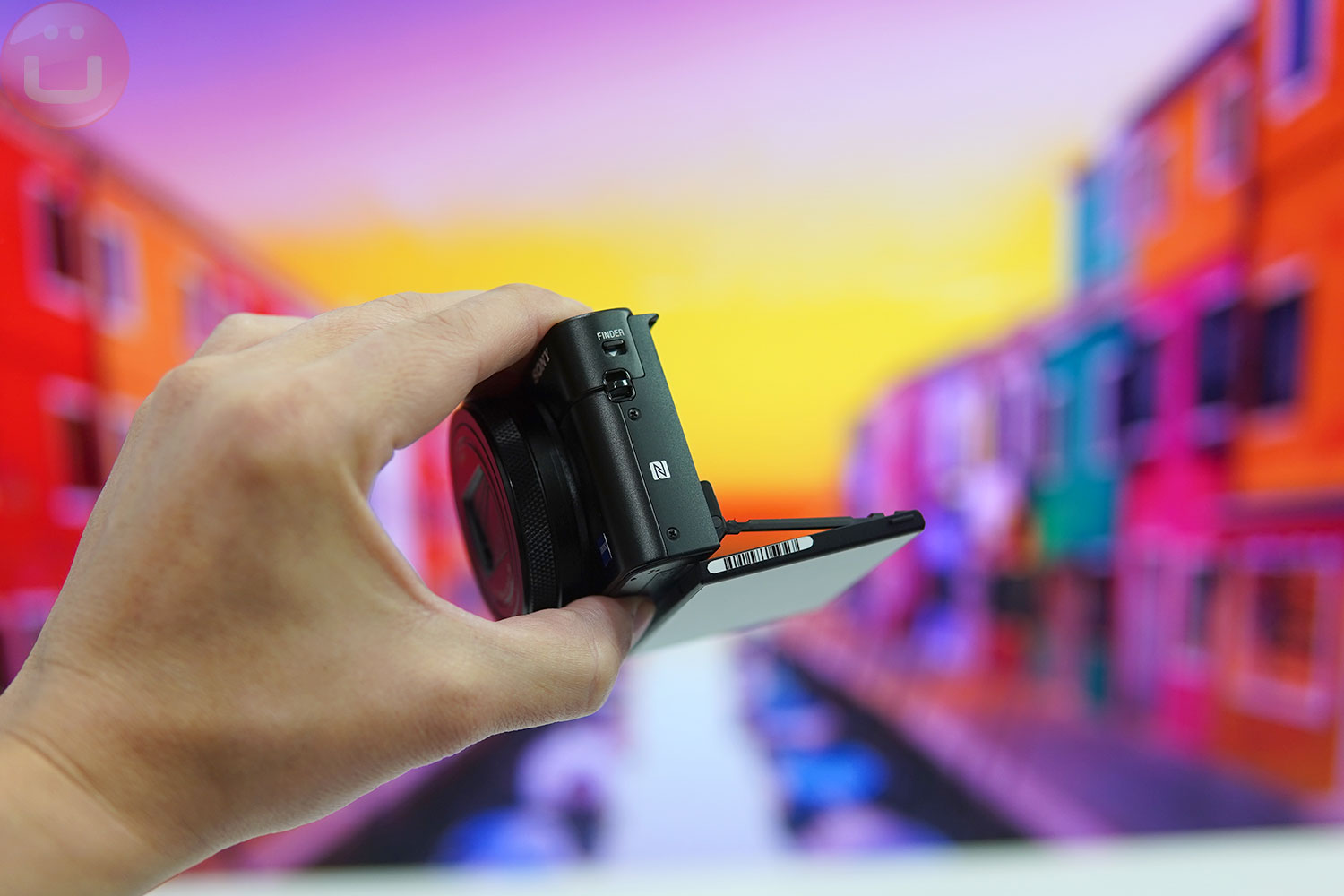
In the back, the display tilts to 180-degrees upwards for Vlogging and selfies. If you raise the camera up above your head, you can tilt the screen downwards a full 90-degrees. Sony’s hinge is superior to some competing compact cameras that can’t tilt that low.
On the right side of the camera, three ports are covered by plastic flaps: micro HDMI, micro USB, and a 3.5mm microphone input. The standard audio connector opens a lot of possibilities for sound recording improvements via external microphones. We’d love to see a USB-C port in the future as all our sync/charge gears have moved to that format.
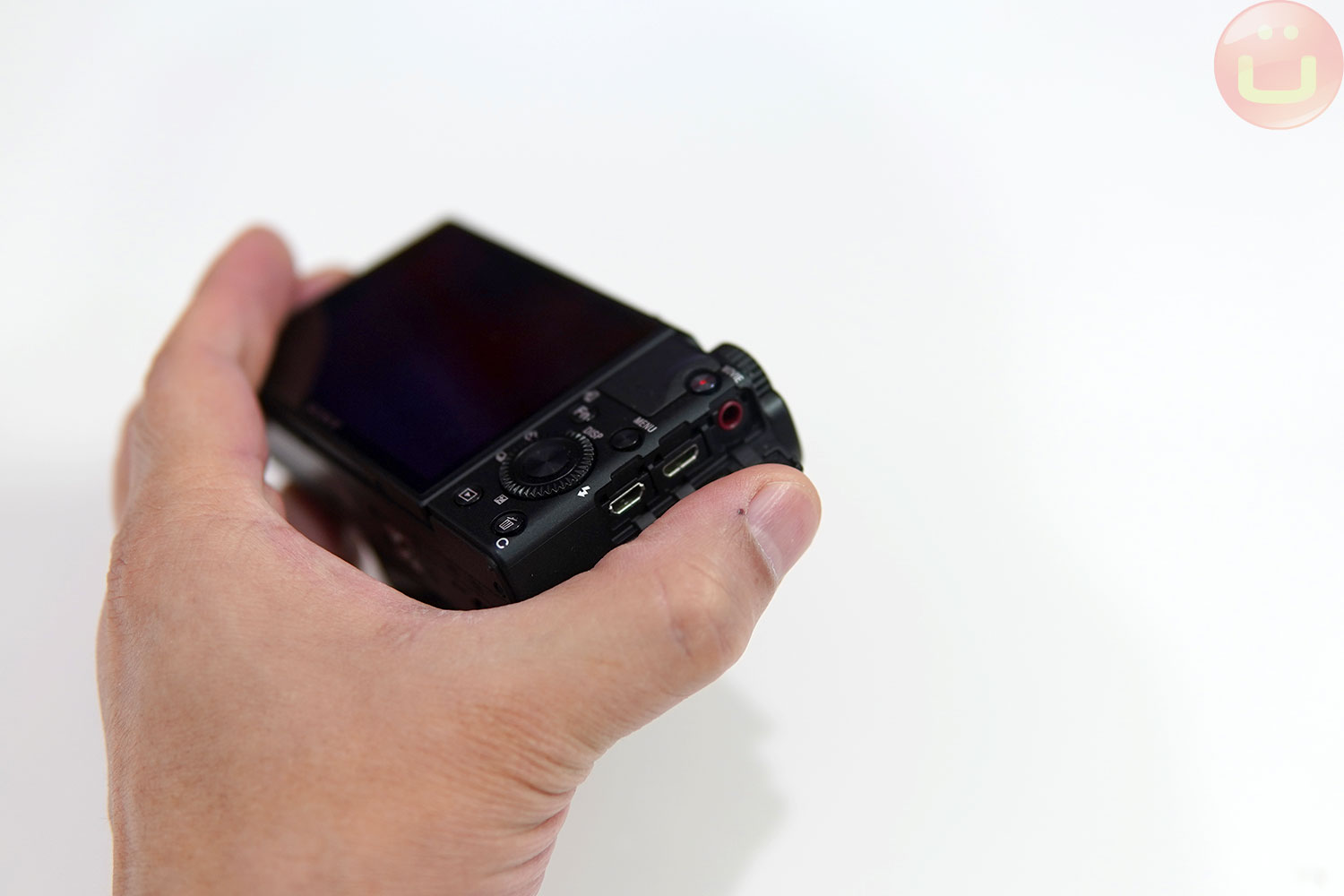
Without a doubt, the 3.5mm audio is one of the new things that Creative users were eagerly waiting for, and Sony caved in as competing products do provide it. The compact design makes it particularly hard to add stuff, but to if you target a Creative crowd, you must have excellent audio options. That’s probably the #1 complaint on Youtube videos.
There’s no microphone shoe, and depending on how you rig the microphone, the final rig size may actually be more substantial than with one of the competing cameras that has a microphone shoe.
If you don’t use an external microphone, you might be able to use the Sony RX100 VII on a gimbal stabilizer that was designed for phones. There are many situations to consider, depending on your situation.
The photo quality of the Sony RX10 is excellent for its class, and for many vloggers and creatives, that justifies carrying it around as a “do it all” camera. Although many people compare the quality with something like an A6500 or above, I wouldn’t go that far, even with the default kit lens.
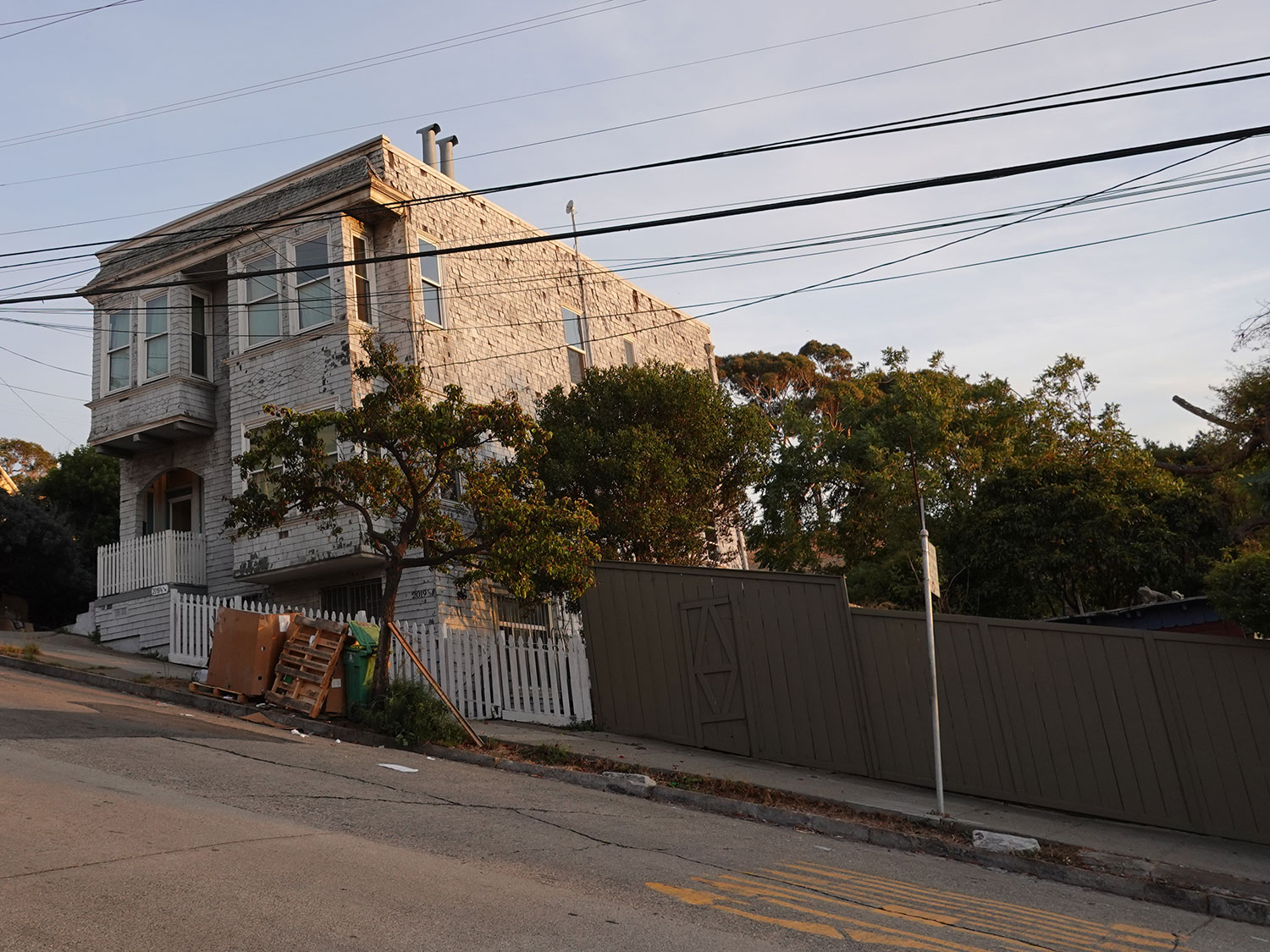
In full-auto, the RX100 VII captures natural-looking photos with great texture and like-like colors, in relatively difficult lighting situations.
The RX100 VII has the advantage of coming with a 24-200mm lens, which is much more flexible than many of the Sony NEX kit lenses that have a much more limited range. In that sense, I found it to be a more polyvalent camera than most mirrorless (out of the box).
At 24mm, the f/2.8 aperture is very reasonable and also allows for beautiful bokeh effects (out of focus blur). At 200mm the f/4.5 aperture is much smaller, and it’s quite common, but I rarely find myself using the telephoto in very low-light conditions, regardless of the camera.
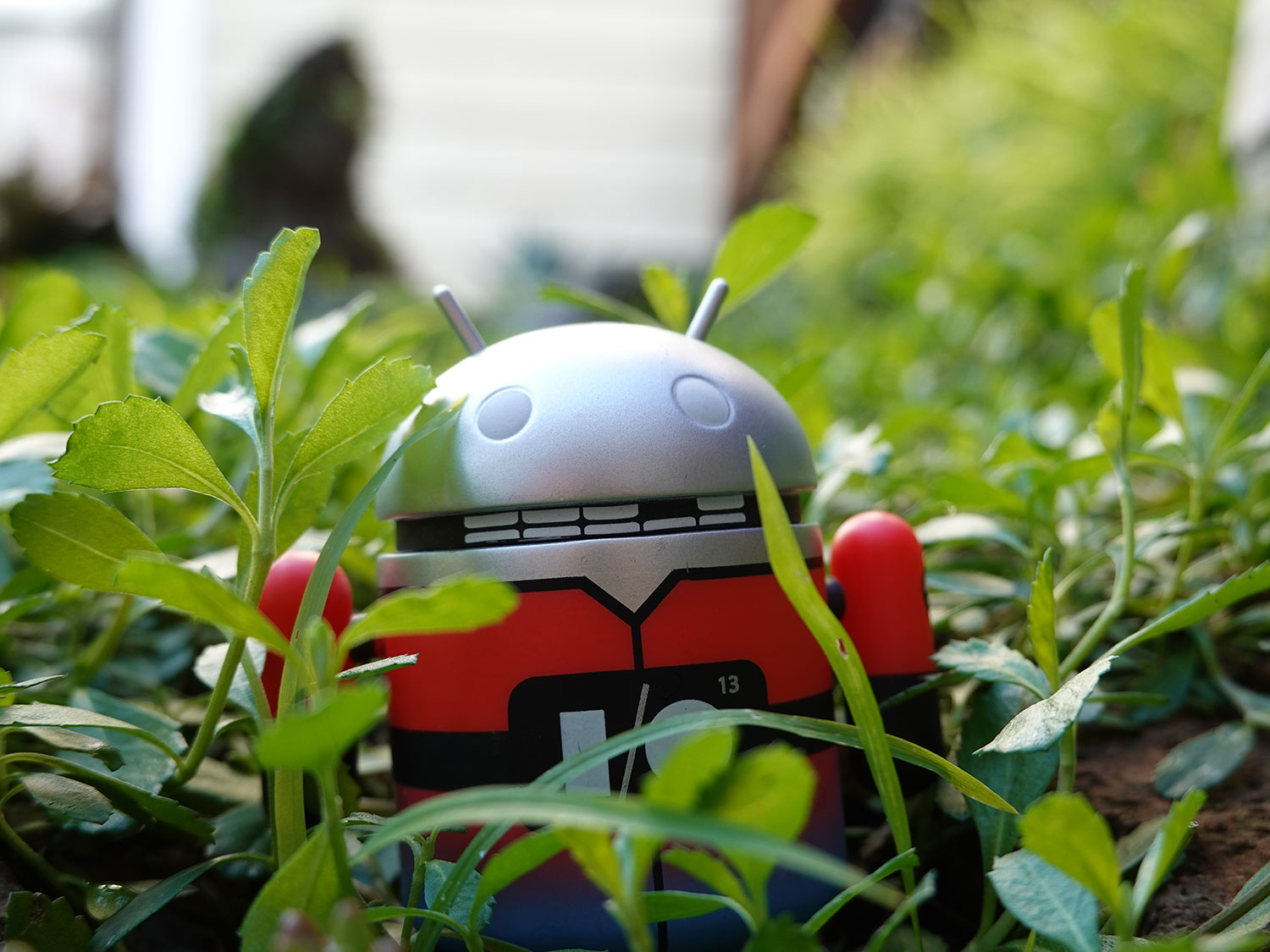
The analog blur of the RX100 is soft and artifact-free since it is caused by the lens and not by algorithms.
The autofocus (AF) is a highlight of the Sony RX100 VII, and it’s true that it reminds me of when we first covered the Sony A9 in 2017.
With 357 phase-detection points and 425 contrast-detection points, the AF can work in 0.02 seconds, according to Sony. And yes, it feels speedy. That’s not quite as much as the 693 AF points of the original Sony A9, but the RX100 VII AF performance is very satisfying.
The Face/eye tracking can be beneficial for subjects in motion (works on animals too), mainly since you can shoot at 20 frames per second (with tracking), without any blackouts.
There’s another option for bursts of 80 Shots in RAW+JPG at up to 90 FPS, but the time-frame is very short. I would probably use 20 FPS and have a few seconds’ of motion, but it’s nice to have the 90FPS option if you can time it correctly.
You can also set the AF point with the touch-screen of the Sony RX100, and that’s really the only practical use for the touch functionality. None of the menus or interface will work with touch at the moment.
I found myself using the touch AF quite often because the RX100 VII has a tendency to focus on things that are in the foreground, so I needed to pay attention to the on-screen focus hints. I had a few photos where the AF decided to focus elsewhere, something that didn’t happen with my Sony A7 III or any of the smartphones I had on me that day.
When it comes to video, the RX100 VII has a lot to offer, including 4K video recording at 30 FPS, at a maximum of 100MB/s/
The overall video quality is outstanding and does well with high-contrast (HDR) scenes as well. I found the video to be a bit grainy in dim lighting, but I haven’t experimented with the many picture profiles that Sony has, and it can make a big difference depending on the scene.
There are new 480 and 960 FPS slow-motion, in addition to 240 FPS. You still have to prepare all the image settings before shooting and note that 480 and 960 FPS do require more light, and the image quality tends to suffer. 240 FPS works just as you expect, and it’s probably the most-used slow-mo mode. Hopefully, Sony will make slow-mo easier to use, with more automation.
Like previous Sony cameras, this one can get very hot when recording in 4K, and the default time out is ~5mn, but you can also make it temperature-dependent by enabling “Auto Power OFF Temp.” in the menu. This also gives you an option to cool it with a fan, if you are vlogging in your studio.
There’s an active image stabilization (digital) that helps when you are walking around. It is not as smooth as a GoPro 7 or some of the new smartphones, but it makes the video much more usable out of the box.
As I said before, the addition of a 3.5mm microphone connector will vastly increase the sound quality options, at the price of a clunky setup, perhaps.
It’s not news that the compact camera industry has been decimated by the rise of smartphone cameras. Mobile camera quality is the #1 purchase criteria, and it’s so important that we built our own Mobile Photo Quality benchmark (Camera IQ), along with a Camera Hardware Benchmark (Camera HW).
So, if you have some of the best mobile cameras out there, is it worth getting the Sony RX100 VII? Well, it depends.
In absolute terms, and even in full auto mode, the Sony RX100 VII produces higher-quality photos than the best phones, with more natural rendering without excess filtering and in higher resolution, whether it is in daylight or low-light.
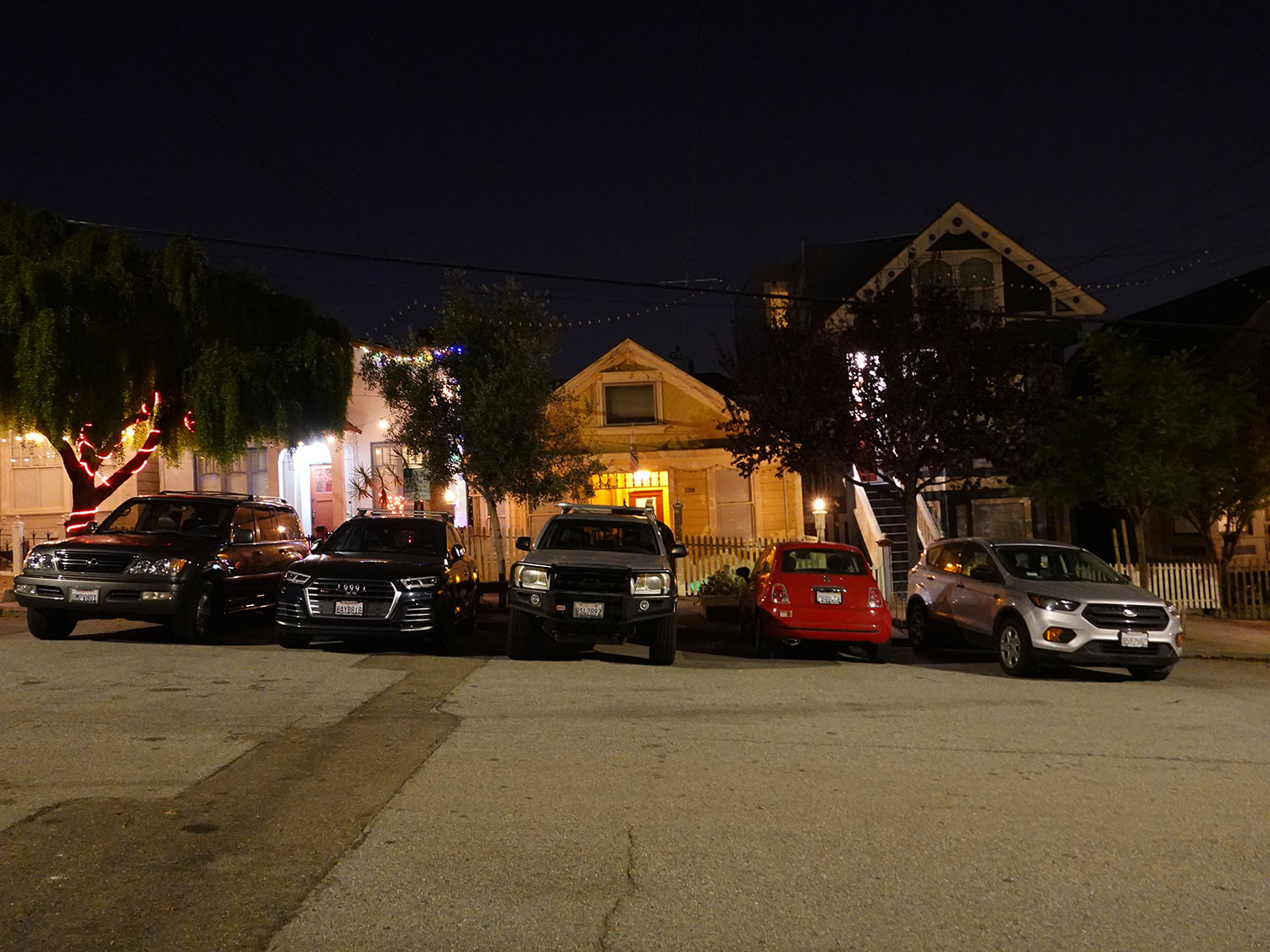
In low-light, the RX100 VII does brighten the scene a bit, but delivers more-natural images than phones.
A camera such as the RX100 VII will naturally capture much better bokeh than a smartphone because its lens is large enough to create real Bokeh. And of course, the bokeh is also present in videos, something that very few phones can do, and none can do as well.
Phone lenses are too small, so they fake the bokeh effect by computing the distance to the camera, but it is a bit hacky, and it is common to see artifacts on the edges or in hairs.
With the Sony RX100 VII, just focus on your shoot and set the aperture to maximum, and voila, it just works. This is an advantage that smartphones have not (yet) been able to work around, in my opinion.
The RX100 VII also captures life-like photos and videos, and you won’t have to deal with the extra filtering that phones often have, including making stuff supernaturally bright.
However, high-end smartphones are generally much better with HDR photos (high dynamic range) in tricky high-contrast situations. They just pack more computing power, and the software stack is much better when compared to the software in standalone cameras.
In my opinion, if you want better absolute quality, better bokeh, and a more natural-looking capture (less filtering), then the Sony RX100 VII can easily justify owning one. Quality gives you more options for what you can do later with your photos. That’s the reason why influencers and pros would consider getting one.
The 200mm telephoto is also far superior to any smartphone solutions now, even the P30 Pro, which has the most potent zoom of all. In many situations, I found the AF tracking to be superior as well, for movie recording, or action/sports photos.
If you just want to share on the web, or post on social media and don’t care that much about photo details and perhaps color accuracy, then you might the quality gap between the Sony RX100 and high-end smartphones is not large enough to justify the expense.
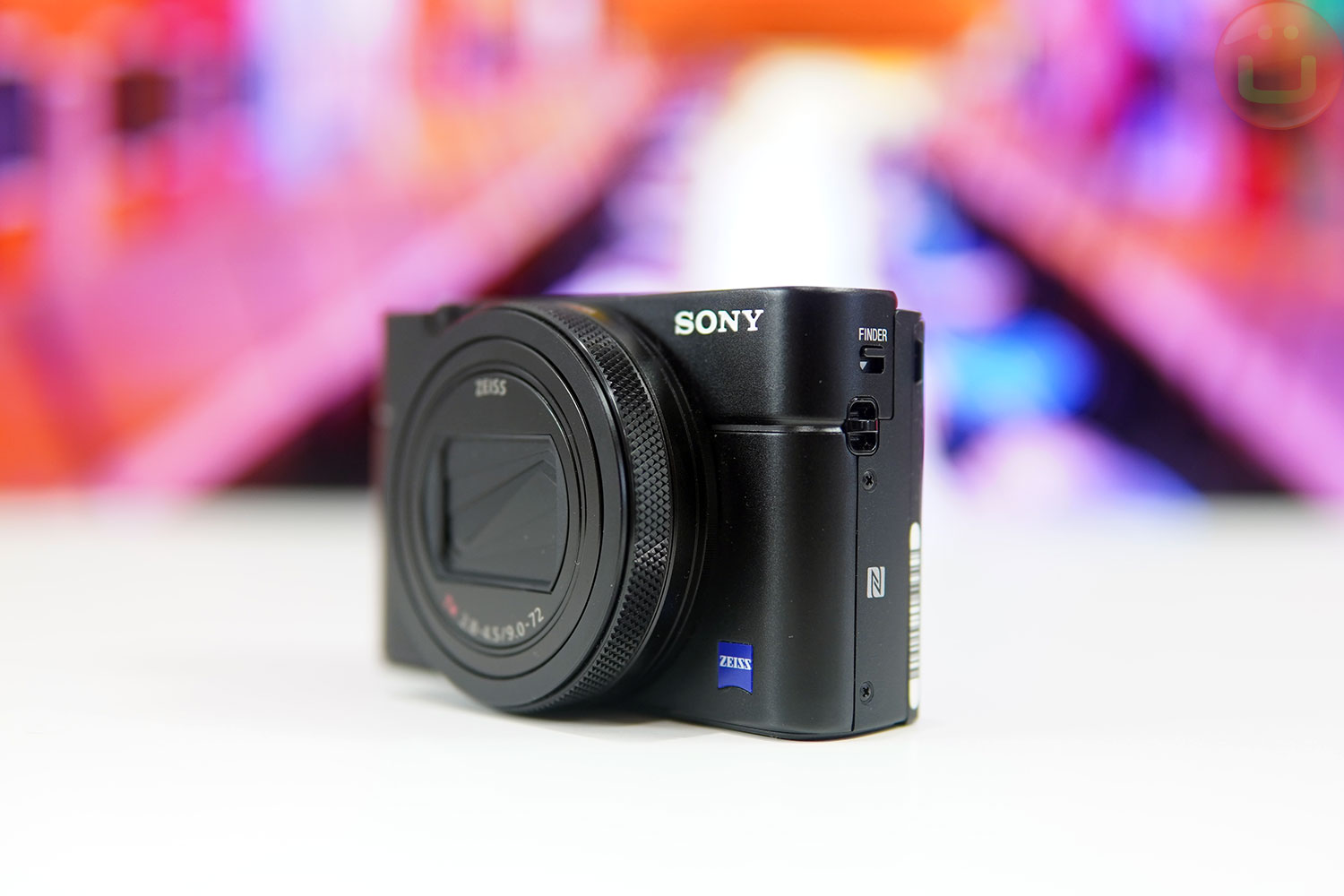
The Sony RX100 VII is the ultimate evolution of a successful line of product which has been praised by many creative users. Even with the rise in the quality of smartphone cameras, there are still many compelling reasons to get one of these, depending on your needs (and bank account).
I already have a Sony NEX 6000, 6400, and 6500, along with a Sony A7 III, and while I would happily replace one the mirrorless with the RX100 VII for a specific job and mainly for the light weight. However, I would keep using the interchangeable-lens cameras because I need larger apertures and the image quality is higher.
I didn’t spend much time talking about the menus and functions of the camera, but it is functionally a fully-featured camera and felt very much like using one of the mirrorless mentioned above most of the time. Sony users will be very comfortable with the interface.
Overall, I find this camera to be outstanding, and I wouldn’t be surprised if it was the best in its class, but I haven’t had enough playtime with the competition to make that final call.
Sony RX100 VII Camera: My Experience , original content from Ubergizmo. Read our Copyrights and terms of use.

Back in the early days of gaming consoles, each box, if you could really call them a box, exuded some personality with a unique and almost eccentric design. Perhaps due to the changing aesthetic tastes of the gaming market, that design trend stopped after the first Xbox and PlayStation consoles. Leaked patents almost suggested that the PlayStation 5 could once … Continue reading
As the year wraps up, it’s time to start looking back on some of its best media, including arguably one of the best horror movies to come out in years, Jordan Peele’s Us. This excellent poster is a great way to commemorate it.
“Under the current circumstances, we do not intend to participate,” White House Counsel Pat Cipollone wrote on Sunday.
 Due to the fact that more games are being created as multiplayer games, it also means that there is a rise in online communities, which in turn has also unfortunately resulted in some of them being rather toxic. However, in a bid to try and create a less toxic environment for gamers, a Vatican priest by the name of Fr. Robert Ballecer, decided to create the Vatican’s Minecraft server where he hopes that it would foster a less toxic community.
Due to the fact that more games are being created as multiplayer games, it also means that there is a rise in online communities, which in turn has also unfortunately resulted in some of them being rather toxic. However, in a bid to try and create a less toxic environment for gamers, a Vatican priest by the name of Fr. Robert Ballecer, decided to create the Vatican’s Minecraft server where he hopes that it would foster a less toxic community.
The idea of this server is that it will be an environment where players will be able to freely express themselves and their creativity and also build relationships with each other. Speaking to Rome Reports, Ballecer said, “It’s not about the technology, it’s not even really about the gaming. It’s about getting people together who can then maybe move those relationships to the real world.”
He adds that there was some resistance at the start, namely due to the fact that he is a priest. “At first, there were a lot of people who were very hesitant. Because you see this guy in a collar talking about the latest offerings from Google, or how you run fiber optics across the Atlantic. And they didn’t understand, they said, ‘Wait a minute, these two things don’t go together.’ But after a time, they realized, ‘Okay, he knows what he’s talking about, he just happens to be a priest.’ And ultimately, that was the ministry I was trying to do.”
The Vatican Minecraft server is currently in testing but if you’re interested in checking it out, you can head on over to its website for the details.
Vatican Prient Launches His Own Minecraft Server To Tackle Toxic Gaming , original content from Ubergizmo. Read our Copyrights and terms of use.
 When it comes to traffic cameras, most of them are typically used to catch speeders who break the legal speed limit and also to catch those who try to beat the red lights. However, when it comes to catching distracted drivers who might be texting while driving, that’s a little tricky and is usually a manual process.
When it comes to traffic cameras, most of them are typically used to catch speeders who break the legal speed limit and also to catch those who try to beat the red lights. However, when it comes to catching distracted drivers who might be texting while driving, that’s a little tricky and is usually a manual process.
At least that’s the case for the rest of the world except for Australia, where the country’s government has rolled out what is possibly be the world’s first AI camera that can catch distracted drivers who are using their phones while driving. This will be initially rolled out in the state of New South Wales where the government is hoping that with the ability to spot drivers who are texting while driving, it will deter them which in turn will help reduce related accidents.
According to Minister for Roads Andrew Constance, “Some people have not got the message about using their phones legally and safely. If they think they can continue to put the safety of themselves, their passengers and the community at risk without consequence they are in for a rude shock.”
Drivers who are caught texting while driving during the first three months of the system going live will receive a warning letter. Following that, drivers who are caught will then receive a $344 fine and five demerit points. There are plans to expand on the system where it is expected to perform as many as 135 million vehicle checks each year by 2023.
Australia Rolls Out AI Cameras To Spot Distracted Drivers , original content from Ubergizmo. Read our Copyrights and terms of use.
 Tesla’s Cybertruck raised a few eyebrows when it was announced. It sports an odd shape and for some reason, Tesla decided to give it a reinforced body and windows as well. However, it seems that despite some of the questionable design choices, there are many who are on board with this, such as Dubai’s police force.
Tesla’s Cybertruck raised a few eyebrows when it was announced. It sports an odd shape and for some reason, Tesla decided to give it a reinforced body and windows as well. However, it seems that despite some of the questionable design choices, there are many who are on board with this, such as Dubai’s police force.
In a tweet by the official Dubai Police Twitter account, they have announced that they will be adding the Cybertruck to their vehicle fleet. However, the tweet mentions that the Cybertruck will be added in 2020, which is odd because production of the vehicle is only expected to begin in 2021. We’re not sure if it’s a typo or if the Dubai Police will be given early access, but either way, it seems that they are interested in it.
That being said, some have pointed out that the Dubai Police seem to have a penchant for having an eclectic choice when it comes to police cars. For example, one of the cars part of its fleet is an ultra-rare Aston Martin One-77, which hardly seems like the kind of car you want to be chasing criminals down with.
شرطة دبي – 2020 – Dubai Police #CyberTruck pic.twitter.com/V9rMPLgjS4
— Dubai Policeشرطة دبي (@DubaiPoliceHQ) November 26, 2019
In the meantime, despite the odd shape and design of the Cybertruck, Tesla’s CEO Elon Musk had previously boasted how the company had received more than 140,000 reservations for it. Whether or not those reservations will stick until the vehicle rolls off the production lines remains to be seen.
Tesla’s Cybertruck Will Be Added To Dubai’s Police Fleet , original content from Ubergizmo. Read our Copyrights and terms of use.